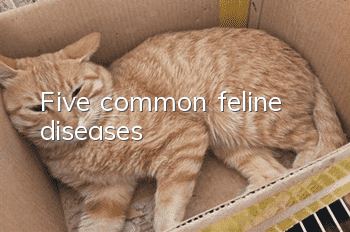What are the causes of dislocation in cats? How to treat dislocation in cats

What are the causes of dislocation in cats
Dislocation refers to the loss of normal correspondence between bones. Generally, dislocation can be divided into three categories: congenital dislocation (the probability of this happening is relatively small), traumatic dislocation, and pathological dislocation. The causes of dislocation in cats vary, and owners should try to avoid these situations.
1. Usually when the external force acting on the bone exceeds the physiological range of motion of the joint, traumatic dislocation (indirect dislocation) is often caused. Occasionally, dislocation occurs when external force acts directly on the joint (direct dislocation).
2. Pathological dislocation occurs when excessive synovial fluid causes the joint capsule to expand, or when the joint connection is detached due to paralysis of the muscles that fix the joint, or when the bones that constitute the joint are destroyed.
3. Congenital dislocation occurs during the fetal period due to various reasons, but this situation rarely occurs.
We cannot avoid congenital dislocations, but dislocations caused by external forces can be prevented as long as we are more careful. Therefore, owners should pay more attention when taking care of cats to prevent this type of dislocation. Unexpected circumstances occur.
What are the symptoms of cat dislocation
Do not allow a dislocated cat to move around at will to avoid joint damage caused by friction between joints. Some owners may not be able to tell whether their cat has dislocated after being subjected to some external force, so we will describe some of the corresponding symptoms of cat dislocation.
1. Deformation: Due to the displacement of the joint head, the joint cannot maintain its normal shape, causing abnormal protrusions or depressions. This deformation can be palpated when located on the surface of the body.
2. Changes in movement performance: Under normal circumstances, various joints have a certain range of mobility, but most of them lose their mobility when dislocated. However, when the joint capsule or ligament is torn along with dislocation, abnormal movement beyond the normal range of motion occurs.
3. Pain and swelling: Compared with fractures and sprains, pain is generally mild and relieves over time. Except for direct dislocation, the swelling is not obvious, but some may cause subcutaneous bleeding or joint hematoma.
4. Elastic fixation: Generally, after a limb joint is dislocated, its fixation is in a dislocated state. If it is artificially reset to its normal position, there will be a sense of elastic resistance. When the external force is removed, it returns to its original position, which is called elastic fixation or clockwork fixation.
5. Dysfunction: When a limb is dislocated, most of the affected limbs remain dislocated. The completely dislocated limbs become shorter, while the incompletely dislocated limbs become longer, showing branch or mixed lameness. When the mandible is dislocated, the mouth cannot be closed and bleeding occurs.Saliva cannot feed. When the sacroiliac joint is dislocated, the pelvic cavity sometimes becomes narrowed. When a complex dislocation occurs, nerve disorders, severe pain, and heat absorption may occur depending on the degree.
Diagnosis and treatment of cat dislocation
Diagnosis:
1. As long as obvious displacement, joint deformation and immobility are observed through inspection and palpation, the diagnosis can be easily made.
2. For sick cats with unclear symptoms, differential diagnosis needs to be made with fractures, muscle paralysis, sprains or contusions. In particular, fractures need to be differentiated.
3. Since dislocation is often accompanied by fracture, when a fracture is suspected, X-ray examination should be performed. This examination is especially needed for the identification of intra-articular fractures and traumatic bone end separation.
Treatment:
1. Restoration: The principle of restoration of joint dislocation is to first force traction along the long axis of the joint to temporarily separate the joint surfaces, and then restore the displaced joint surfaces to their normal position. Depending on the structure of the joint and the state of dislocation, the rehabilitation techniques vary. General anesthesia is required to relieve pain caused by muscle tension and traction on nerves. During the reconstruction process, if the injured joint capsule, ligaments, or muscles hinder the reconstruction operation, or if there is old healing or is accompanied by fractures, it is necessary to perform reconstruction after surgery.
2. Fixation: If only rehabilitation is performed without other treatment, the joints will often dislocate. Therefore, it needs to be fixed within a certain period of time after reconstruction. Fixation methods vary depending on the type of joint and the degree of dislocation. For hip dislocation, use a bandage to immobilize the affected limb in a flexed position for 7 to 10 days. For the mandibular joint, the upper and lower jaws are tied tightly with a rope, and liquid food is fed between the teeth. In addition, for the sacroiliac joint, steel wires are threaded from the side for fixation. For other joints, wooden boards, plaster bandages or plastic bandages are used to fix them.
3. Function recovery: For cats, because the immobilization time is relatively short, functional disorders such as joint ankylosis due to immobilization are relatively minor. However, if an obstacle occurs, the function can be restored through massage, warm compress, ultrasonic therapy or mild exercise.
4. Drug treatment: For open dislocation or surgical operation, systemic therapy such as antibiotic therapy should be implemented.
- Tips for removing black chin in cats
- What does a cat eat to produce a lot of milk?
- The kitten keeps blinking one eye
- What to do if a cat is afraid of people
- There's a reason why cats always lick their fur
- What should I do if my cat refuses to have its nails cut?
- What should I do if my cat refuses to cut its nails? The shit shovel officer can do this!
- How to choose a Russian blue cat
- How to check if your cat has fleas and ticks?
- How to tell if a cat has a fever? Will a cat's fever heal on its own?



